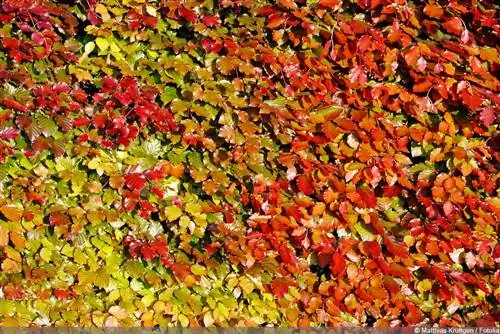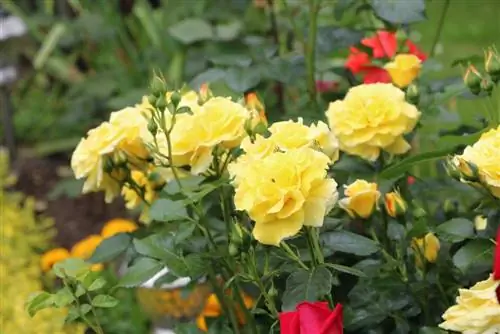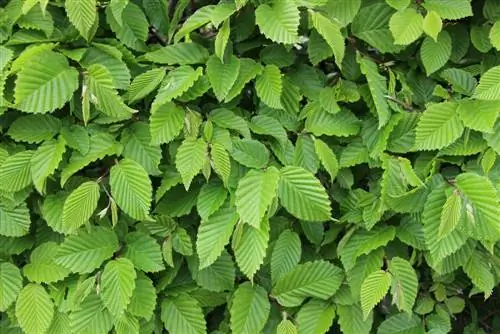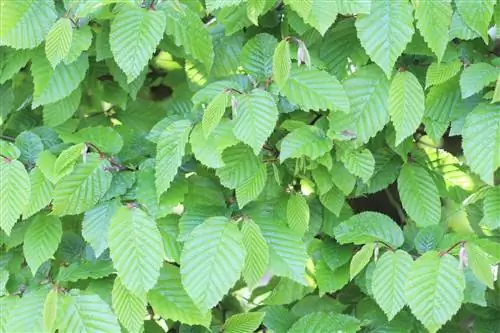- Author admin [email protected].
- Public 2023-12-17 03:39.
- Last modified 2025-06-01 06:48.
To simply describe the copper beech hedge as an attractive plant would be a complete understatement. With its dense foliage and striking dark red leaves, it exerts a real magic that more and more garden owners are succumbing to. Yes, it is definitely an eye-catcher in every garden. The copper beech hedge is particularly suitable as a perfect, barely penetrable privacy screen at property boundaries.
Location
The copper beech hedge is definitely one of the really uncomplicated garden plants. This is evident from the fact that it can grow and thrive in practically any location. Regardless of whether it is sun, partial shade or shade - the copper beech can cope with it. This flexibility is of course a great advantage if the hedge is to be used as a privacy screen in the garden. This is often necessary especially where the site conditions may not be ideal. The enormous adaptability of the copper beech hedge naturally plays into the hands of a garden owner in such a case. Nevertheless, there is of course the perfect location for this plant where it grows particularly well. And it should be as sunny as possible.
Floor
In the copper beech hedge there is a tree, a variation of the copper beech, that only turns into a hedge because it is regularly cut and planted in a row. However, the tree character means that the plant has very deep roots. So that the heart roots in particular find the necessary support in the soil, medium to deep soil is recommended. It should also be as rich in humus as possible and have a low lime content. High clay contents are also ideal as this allows water to be stored better in the soil. So that the copper beech hedge can develop optimally, the pH value is best in a range between 5.0 and 7.5.
Planting spacing
The first step on the way to a perfect hedge is planting the copper beech correctly. The planting distance plays a particularly important role here. A distance of 50 to 80 centimeters between the individual plants has proven to be perfect. Half of the growth width should definitely be maintained as a minimum distance. As a general rule, there can be a maximum of two individual plants per square meter. If the copper beech is not grown as a hedge, the distances can of course be significantly larger. However, a minimum distance of 15 meters from walls and roofs is then necessary. When planting, proceed as follows:
- Dig the planting hole (minimum size: twice the width of the root ball)
- Insert the root ball and cover with soil up to the top end of the root
- Tamp soil around the stem
- water well with water immediately
- Repeat the process for the other plants in the hedge
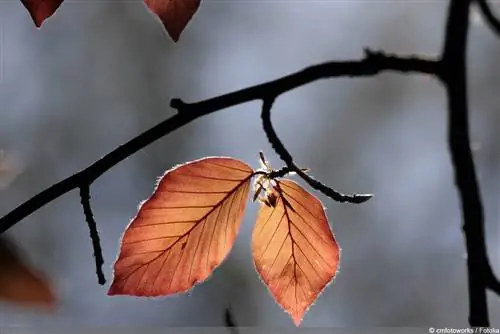
By the way, the best time to plant a copper beech hedge is spring. Plants planted in March or April then have enough time to develop well until winter.
Tip:
In order to guarantee good water drainage, the planting hole can be dug a little deeper and provided with drainage. Pebbles or pottery shards are suitable materials.
Pouring
The copper beech hedge also needs a lot of water, especially in summer. Longer dry periods or even complete drying out can lead to significant damage. It is therefore important to water as soon as the top layer of soil has dried. We recommend checking regularly with your finger. On the other hand, waterlogging must be avoided at all costs. It inevitably leads to root rot, which sooner or later kills the plant. So too much water is not a solution either. Since copper beeches not only cope well with lime, but also require a certain amount of lime for their growth, they can also be watered with very hard water without any concerns.
Fertilize
The copper beech hedge is only fertilized from the beginning of March to the end of July. By August at the latest, the additional administration of nutrients must be stopped completely, otherwise significant growth damage could occur. So-called long-term fertilizers, which are administered once a month, are particularly suitable as fertilizers. In spring, growth can also be stimulated with blue grain. The soil should also be enriched with mulch and compost around the plants in spring and autumn. Horn shavings can also be used. In general, copper beech hedges should only be fertilized in moderation. It is also important that the fertilizer does not come into contact with shoots and leaves.
Cut
Regular pruning, at least once a year, is a must for every hedge. Of course, this also applies to the copper beech hedge. However, the right time plays a big role for her. Since there is a tree in it and therefore a very deep-rooted plant, the cut must be done in spring before the first leaves emerge. The months of April and May are ideal for this. In this phase, wound healing occurs the fastest. If the copper beech hedge shows very strong growth, it should be trimmed again in the summer. Ideally, this second cut is done in August so that new shoots can grow out well before autumn or winter. If, on the other hand, the hedge is not so keen to grow, one cut per year is sufficient.
Editing technique
During the first cut or the basic cut, at least half of a new shoot is removed. Cutting always starts at the sides of the hedge. When shaping, it is important to ensure that the hedge is wider at the bottom than at the top. This ensures that the lower branches and leaves also receive enough light. Once the sides are done, it's time for the top end. The best cutting tool to use is an electric hedge trimmer. Incidentally, the copper beech hedge does not tolerate radical pruning particularly well, which is why annual cutting is definitely recommended. If you want to do something good for your hedge after cutting, spray the branches and leaves with water as an exception.
Diseases and pests
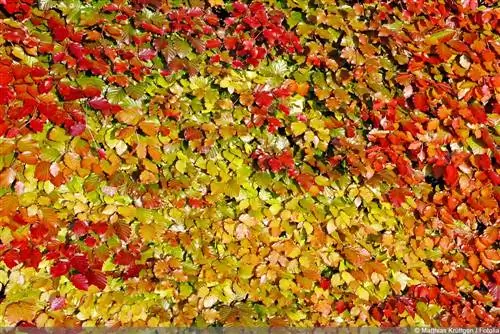
As uncomplicated as the copper beech hedge may be, it is not immune to diseases and pests. Proper care is an important contribution to preventing problems. So-called leaf browning is relatively common on copper beech hedges. It is caused by a fungal infection and can only be combated with a fungicide from a specialist retailer. The beech mealybug can also be dangerous for the hedge. If it occurs, it is best to spray the entire hedge with a nettle decoction. In the case of an infestation with the beech leaf gall midge, however, an insecticide is required. In addition, the fallen leaves should be removed and disposed of in autumn, as the mosquito larvae hide in them.
Tip:
In order to detect a possible pest infestation or disease early, the plant should be checked regularly. A clear warning signal is a lot of wilted leaves in spring and summer.
Wintering
The common beech and therefore also the copper beech hedge are native plants. As a result, they cope excellently with the weather conditions in our latitudes. In other words: A copper beech hedge is hardy and can survive even severe frosts. Overwintering is therefore not necessary - and would hardly be possible with a hedge.

